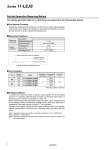
11-lejs 3 / 9
10秒後にBOOKのページに移動します
Particle Generation Measuring Method The particle generation data for 11-LEJS series are measured in the following test method. Evaluation Method To obtain the measured values of particle concentration, the accumulated value Note 1) of particles captured every 5 minutes, by the laser dust monitor, is converted into the particle concentration in every 1 m3. When determining particle generation grades, the 95% upper confidence limit of the average particle concentration (average value), when each specimen is operated at a specified number of cycles Note 2) is considered. The plots in the graphs indicate the 95% upper confidence limit of the average particle concentration of particles with a diameter within the horizontal axis range. Note 1) Sampling air flow rate: Number of particles contained in 141.5 L (ANR) of air Note 2) Actuator: 1 million cycles Note 3) The particle generation characteristics (Page 2) provide a guide for selection but is not guaranteed. Test Method (Example) Operate the specimen that is placed in an ISO Class 5 (Class 100) equivalent clean bench, and measure the changes of the particle concentration over time until the number of cycles reaches the specified point. Test Conditions Size Speed [mm/s] Model Workpiece mass [kg] Acceleration [mm/s2] Duty ratio [%] 40 1200 11-LEJS40A-200 4 13000 100 600 11-LEJS40B-200 10000 63 1200 11-LEJS63A-300 13000 600 11-LEJS63B-300 10000 * Mounting position: Horizontal Measuring Conditions Measuring instrument Description Laser dust monitor (Automatic particle counter by lightscattering method) Minimum measurable particle diameter 0.1 μm Suction flow rate 28.3 L/min (ANR) Setting conditions Sampling time 5 min Interval time 55 min Sampling air flow 141.5 L (ANR) Vacuum suction from vacuum port Laser dust monitor Clean bench (ISO Class 5 equivalent) Particle generation measuring circuit 1 Series 11-LEJS